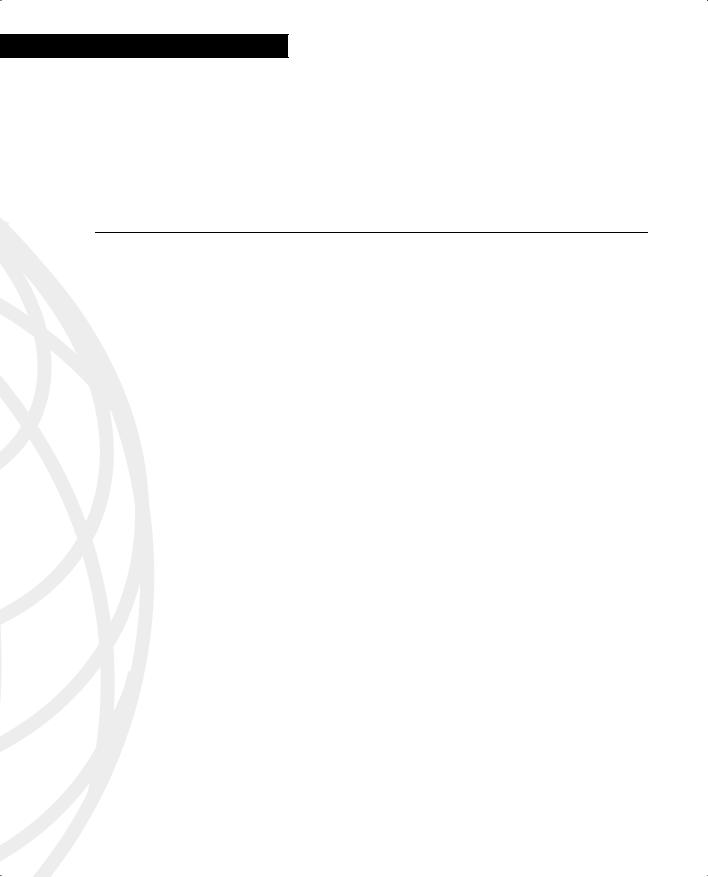
- •QoS Overview
- •“Do I Know This Already?” Quiz
- •QoS: Tuning Bandwidth, Delay, Jitter, and Loss Questions
- •Foundation Topics
- •QoS: Tuning Bandwidth, Delay, Jitter, and Loss
- •Bandwidth
- •The clock rate Command Versus the bandwidth Command
- •QoS Tools That Affect Bandwidth
- •Delay
- •Serialization Delay
- •Propagation Delay
- •Queuing Delay
- •Forwarding Delay
- •Shaping Delay
- •Network Delay
- •Delay Summary
- •QoS Tools That Affect Delay
- •Jitter
- •QoS Tools That Affect Jitter
- •Loss
- •QoS Tools That Affect Loss
- •Summary: QoS Characteristics: Bandwidth, Delay, Jitter, and Loss
- •Voice Basics
- •Voice Bandwidth Considerations
- •Voice Delay Considerations
- •Voice Jitter Considerations
- •Voice Loss Considerations
- •Video Basics
- •Video Bandwidth Considerations
- •Video Delay Considerations
- •Video Jitter Considerations
- •Video Loss Considerations
- •Comparing Voice and Video: Summary
- •IP Data Basics
- •Data Bandwidth Considerations
- •Data Delay Considerations
- •Data Jitter Considerations
- •Data Loss Considerations
- •Comparing Voice, Video, and Data: Summary
- •Foundation Summary
- •QoS Tools and Architectures
- •“Do I Know This Already?” Quiz
- •QoS Tools Questions
- •Differentiated Services Questions
- •Integrated Services Questions
- •Foundation Topics
- •Introduction to IOS QoS Tools
- •Queuing
- •Queuing Tools
- •Shaping and Policing
- •Shaping and Policing Tools
- •Congestion Avoidance
- •Congestion-Avoidance Tools
- •Call Admission Control and RSVP
- •CAC Tools
- •Management Tools
- •Summary
- •The Good-Old Common Sense QoS Model
- •GOCS Flow-Based QoS
- •GOCS Class-Based QoS
- •The Differentiated Services QoS Model
- •DiffServ Per-Hop Behaviors
- •The Class Selector PHB and DSCP Values
- •The Assured Forwarding PHB and DSCP Values
- •The Expedited Forwarding PHB and DSCP Values
- •The Integrated Services QoS Model
- •Foundation Summary
- •“Do I Know This Already?” Quiz Questions
- •CAR, PBR, and CB Marking Questions
- •Foundation Topics
- •Marking
- •IP Header QoS Fields: Precedence and DSCP
- •LAN Class of Service (CoS)
- •Other Marking Fields
- •Summary of Marking Fields
- •Class-Based Marking (CB Marking)
- •Network-Based Application Recognition (NBAR)
- •CB Marking show Commands
- •CB Marking Summary
- •Committed Access Rate (CAR)
- •CAR Marking Summary
- •Policy-Based Routing (PBR)
- •PBR Marking Summary
- •VoIP Dial Peer
- •VoIP Dial-Peer Summary
- •Foundation Summary
- •Congestion Management
- •“Do I Know This Already?” Quiz
- •Queuing Concepts Questions
- •WFQ and IP RTP Priority Questions
- •CBWFQ and LLQ Questions
- •Comparing Queuing Options Questions
- •Foundation Topics
- •Queuing Concepts
- •Output Queues, TX Rings, and TX Queues
- •Queuing on Interfaces Versus Subinterfaces and Virtual Circuits (VCs)
- •Summary of Queuing Concepts
- •Queuing Tools
- •FIFO Queuing
- •Priority Queuing
- •Custom Queuing
- •Weighted Fair Queuing (WFQ)
- •WFQ Scheduler: The Net Effect
- •WFQ Scheduling: The Process
- •WFQ Drop Policy, Number of Queues, and Queue Lengths
- •WFQ Summary
- •Class-Based WFQ (CBWFQ)
- •CBWFQ Summary
- •Low Latency Queuing (LLQ)
- •LLQ with More Than One Priority Queue
- •IP RTP Priority
- •Summary of Queuing Tool Features
- •Foundation Summary
- •Conceptual Questions
- •Priority Queuing and Custom Queuing
- •CBWFQ, LLQ, IP RTP Priority
- •Comparing Queuing Tool Options
- •“Do I Know This Already?” Quiz
- •Shaping and Policing Concepts Questions
- •Policing with CAR and CB Policer Questions
- •Shaping with FRTS, GTS, DTS, and CB Shaping
- •Foundation Topics
- •When and Where to Use Shaping and Policing
- •How Shaping Works
- •Where to Shape: Interfaces, Subinterfaces, and VCs
- •How Policing Works
- •CAR Internals
- •CB Policing Internals
- •Policing, but Not Discarding
- •Foundation Summary
- •Shaping and Policing Concepts
- •“Do I Know This Already?” Quiz
- •Congestion-Avoidance Concepts and RED Questions
- •WRED Questions
- •FRED Questions
- •Foundation Topics
- •TCP and UDP Reactions to Packet Loss
- •Tail Drop, Global Synchronization, and TCP Starvation
- •Random Early Detection (RED)
- •Weighted RED (WRED)
- •How WRED Weights Packets
- •WRED and Queuing
- •WRED Summary
- •Flow-Based WRED (FRED)
- •Foundation Summary
- •Congestion-Avoidance Concepts and Random Early Detection (RED)
- •Weighted RED (WRED)
- •Flow-Based WRED (FRED)
- •“Do I Know This Already?” Quiz
- •Compression Questions
- •Link Fragmentation and Interleave Questions
- •Foundation Topics
- •Payload and Header Compression
- •Payload Compression
- •Header Compression
- •Link Fragmentation and Interleaving
- •Multilink PPP LFI
- •Maximum Serialization Delay and Optimum Fragment Sizes
- •Frame Relay LFI Using FRF.12
- •Choosing Fragment Sizes for Frame Relay
- •Fragmentation with More Than One VC on a Single Access Link
- •FRF.11-C and FRF.12 Comparison
- •Foundation Summary
- •Compression Tools
- •LFI Tools
- •“Do I Know This Already?” Quiz
- •Foundation Topics
- •Call Admission Control Overview
- •Call Rerouting Alternatives
- •Bandwidth Engineering
- •CAC Mechanisms
- •CAC Mechanism Evaluation Criteria
- •Local Voice CAC
- •Physical DS0 Limitation
- •Max-Connections
- •Voice over Frame Relay—Voice Bandwidth
- •Trunk Conditioning
- •Local Voice Busyout
- •Measurement-Based Voice CAC
- •Service Assurance Agents
- •SAA Probes Versus Pings
- •SAA Service
- •Calculated Planning Impairment Factor
- •Advanced Voice Busyout
- •PSTN Fallback
- •SAA Probes Used for PSTN Fallback
- •IP Destination Caching
- •SAA Probe Format
- •PSTN Fallback Scalability
- •PSTN Fallback Summary
- •Resource-Based CAC
- •Resource Availability Indication
- •Gateway Calculation of Resources
- •RAI in Service Provider Networks
- •RAI in Enterprise Networks
- •RAI Operation
- •RAI Platform Support
- •Cisco CallManager Resource-Based CAC
- •Location-Based CAC Operation
- •Locations and Regions
- •Calculation of Resources
- •Automatic Alternate Routing
- •Location-Based CAC Summary
- •Gatekeeper Zone Bandwidth
- •Gatekeeper Zone Bandwidth Operation
- •Single-Zone Topology
- •Multizone Topology
- •Zone-per-Gateway Design
- •Gatekeeper in CallManager Networks
- •Zone Bandwidth Calculation
- •Gatekeeper Zone Bandwidth Summary
- •Integrated Services / Resource Reservation Protocol
- •RSVP Levels of Service
- •RSVP Operation
- •RSVP/H.323 Synchronization
- •Bandwidth per Codec
- •Subnet Bandwidth Management
- •Monitoring and Troubleshooting RSVP
- •RSVP CAC Summary
- •Foundation Summary
- •Call Admission Control Concepts
- •Local-Based CAC
- •Measurement-Based CAC
- •Resources-Based CAC
- •“Do I Know This Already?” Quiz
- •QoS Management Tools Questions
- •QoS Design Questions
- •Foundation Topics
- •QoS Management Tools
- •QoS Device Manager
- •QoS Policy Manager
- •Service Assurance Agent
- •Internetwork Performance Monitor
- •Service Management Solution
- •QoS Management Tool Summary
- •QoS Design for the Cisco QoS Exams
- •Four-Step QoS Design Process
- •Step 1: Determine Customer Priorities/QoS Policy
- •Step 2: Characterize the Network
- •Step 3: Implement the Policy
- •Step 4: Monitor the Network
- •QoS Design Guidelines for Voice and Video
- •Voice and Video: Bandwidth, Delay, Jitter, and Loss Requirements
- •Voice and Video QoS Design Recommendations
- •Foundation Summary
- •QoS Management
- •QoS Design
- •“Do I Know This Already?” Quiz
- •Foundation Topics
- •The Need for QoS on the LAN
- •Layer 2 Queues
- •Drop Thresholds
- •Trust Boundries
- •Cisco Catalyst Switch QoS Features
- •Catalyst 6500 QoS Features
- •Supervisor and Switching Engine
- •Policy Feature Card
- •Ethernet Interfaces
- •QoS Flow on the Catalyst 6500
- •Ingress Queue Scheduling
- •Layer 2 Switching Engine QoS Frame Flow
- •Layer 3 Switching Engine QoS Packet Flow
- •Egress Queue Scheduling
- •Catalyst 6500 QoS Summary
- •Cisco Catalyst 4500/4000 QoS Features
- •Supervisor Engine I and II
- •Supervisor Engine III and IV
- •Cisco Catalyst 3550 QoS Features
- •Cisco Catalyst 3524 QoS Features
- •CoS-to-Egress Queue Mapping for the Catalyst OS Switch
- •Layer-2-to-Layer 3 Mapping
- •Connecting a Catalyst OS Switch to WAN Segments
- •Displaying QoS Settings for the Catalyst OS Switch
- •Enabling QoS for the Catalyst IOS Switch
- •Enabling Priority Queuing for the Catalyst IOS Switch
- •CoS-to-Egress Queue Mapping for the Catalyst IOS Switch
- •Layer 2-to-Layer 3 Mapping
- •Connecting a Catalyst IOS Switch to Distribution Switches or WAN Segments
- •Displaying QoS Settings for the Catalyst IOS Switch
- •Foundation Summary
- •LAN QoS Concepts
- •Catalyst 6500 Series of Switches
- •Catalyst 4500/4000 Series of Switches
- •Catalyst 3550/3524 Series of Switches
- •QoS: Tuning Bandwidth, Delay, Jitter, and Loss
- •QoS Tools
- •Differentiated Services
- •Integrated Services
- •CAR, PBR, and CB Marking
- •Queuing Concepts
- •WFQ and IP RTP Priority
- •CBWFQ and LLQ
- •Comparing Queuing Options
- •Conceptual Questions
- •Priority Queuing and Custom Queuing
- •CBWFQ, LLQ, IP RTP Priority
- •Comparing Queuing Tool Options
- •Shaping and Policing Concepts
- •Policing with CAR and CB Policer
- •Shaping with FRTS, GTS, DTS, and CB Shaping
- •Shaping and Policing Concepts
- •Congestion-Avoidance Concepts and RED
- •WRED
- •FRED
- •Congestion-Avoidance Concepts and Random Early Detection (RED)
- •Weighted RED (WRED)
- •Flow-Based WRED (FRED)
- •Compression
- •Link Fragmentation and Interleave
- •Compression Tools
- •LFI Tools
- •Call Admission Control Concepts
- •Local-Based CAC
- •Measurement-Based CAC
- •Resources-Based CAC
- •QoS Management Tools
- •QoS Design
- •QoS Management
- •QoS Design
- •LAN QoS Concepts
- •Catalyst 6500 Series of Switches
- •Catalyst 4500/4000 Series of Switches
- •Catalyst 3550/3524 Series of Switches
- •Foundation Topics
- •QPPB Route Marking: Step 1
- •QPPB Per-Packet Marking: Step 2
- •QPPB: The Hidden Details
- •QPPB Summary
- •Flow-Based dWFQ
- •ToS-Based dWFQ
- •Distributed QoS Group–Based WFQ
- •Summary: dWFQ Options

Chapter 10 825
17Name the four methods a Catalyst 3550 can use to classify traffic.
CoS values
IP precedence values IP DSCP values
IP access Lists
18What command enables QoS on the Catalyst 3524?
QoS is enabled by default in a Catalyst 3524. No command is needed.
Q&A
LAN QoS Concepts
1What is instantaneous buffer overrun?
Instantaneous buffer overrun occurs when a switch port TX queue fills for an instant causing packet loss, which can adversely affect real-time applications. In a VoIP conversation, for example, 40 ms of congestion causes an audible clip in the conversation.
2What is meant by the term “1p1q4t?”
This term denotes an interface that has a priority queue, a standard queue, and four drop thresholds.
3What packet or frame marking(s) can a Layer 2 switch use to prioritize traffic?
CoS only.
4What packet or frame marking(s) can a Layer 3 switch use to prioritize traffic?
CoS, IP precedence, or IP DSCP.
5What must be done for a Layer 2 switch to properly classify a packet received from a host across the WAN?
The router must map the IP precedence or IP DCSP value on the packet into a CoS value for the Layer 2 switch to properly classify the packet.
6For a Layer 2 switch to receive a CoS value from a router, what must exist?
An 802.1Q trunk must exist between the router and switch for the CoS value to be present.

826 Appendix A: Answers to the “Do I Know This Already?” Quizzes and Q&A Sections
7What type of router interface supports an 802.1Q trunk to a Layer 3 switch?
An Ethernet subinterface must exist on the router to form an 802.1Q trunk with a Layer 2 switch.
8What is a drop threshold?
Drop thresholds define the amount of the total Layer 2 buffer use that must be reached before a specified class of traffic is dropped.
9What is a trust boundary, and where should it be set?
A trust boundary is the first point in your network where you trust the CoS or ToS markings. Typically this point is on the IP Phones or access layer switches.
Catalyst 6500 Series of Switches
10Name three of the five fields that the Policy Feature Card (PFC) rewrites to perform Layer 3 switching.
Layer 2 (MAC) Destination Address Layer 2 (MAC) Source Address Layer 3 IP Time-to-Live (TTL) Layer 3 Checksum
Layer 2 (MAC) Checksum (also called the frame checksum or FCS)
11Explain why the first packet in a flow may not retain the proper CoS values when a Catalyst 6500 is configured with a PFC.
If this flow is not in the flow cache of the PFC or the CEF FIB of the PFC2, the first packet of the flow is forwarded to the MSFC for a routing decision. After a routing decision has been made, the fist packet in the flow is routed to the correct interface. This rewrites the CoS value to 0. The routing decision populates the flow cache or the CEF FIB, causing subsequent packets to be switched and thereby retain the original CoS value.
12What is the difference between Hybrid mode and Native mode?
Hybrid mode refers to the Catalyst operating system, whereas Native mode refers to an IOS operating system on the Catalyst 6500 series switches.
13What command is used on a Catalyst 6500 running in Hybrid mode to place ports 2/1 through 2/10 in VLAN 10?
set port auxiliaryvlan 2/1-10 10

Chapter 10 827
14What command enables QoS on a 6500 running in Native mode? mls qos
15What queue and threshold is recommended for call control traffic on a Catalyst 6500?
2q1t
16Which series of Ethernet line cards are preferred in the Catalyst 6500 series for QoS? Why?
The 65xx series of Ethernet line cards are preferred due to the increase in buffer size and the addition of a priority queue.
Catalyst 4500/4000 Series of Switches
17Which supervisor engine is preferred on the Catalyst 4500/4000 series? Why?
The Supervisor Engine III or the Supervisor Engine IV are preferred because of the addition of a priority queue, three standard queues, and the ability to use QoS access lists.
18In which queue number does the priority queue reside on a Catalyst 4500 or 4000 with a Supervisor II Engine?
There is no priority queue on a Catalyst 4500 or 4000 with a Supervisor II Engine.
19In which queue number does the priority queue reside on a Catalyst 4500 or 4000 with a Supervisor III Engine?
The priority queue in a Catalyst 4500 or 4000 with a Supervisor III Engine resides in Queue 3.
20What keyword(s) is used to enable the priority queue on a Catalyst 4500 or 4000 with a Supervisor III module?
tx-queue 3 priority high
21Name the four methods a Catalyst 4500 with a Supervisor III uses to classify traffic.
CoS values
IP precedence values IP DSCP values
IP ACLs
22What command enables you to rewrite a the CoS value of a PC attached to an IP Phone with Catalyst IOS switches?
switchport priority extend cos

828 Appendix A: Answers to the “Do I Know This Already?” Quizzes and Q&A Sections
23What trust state are the ports if a 4500 with a Supervisor III in when QoS is enabled?
Untrusted.
24What is dynamic buffer limiting?
DBL is an automated algorithm that manages misbehaving traffic flows by tracking the buffering for each traffic flow and limiting the flow if excessive demands are placed on a buffer.
Catalyst 3550/3524 Series of Switches
25In which queue number does the priority queue reside on a Catalyst 3550?
The priority queue in a Catalyst 3550 resides in Queue 4.
26What command enables QoS on the Catalyst 3550? mls qos
27What trust state are the ports of a 3550 in when QoS is enabled?
Untrusted.
28Name the four methods a Catalyst 3550 can use to classify traffic.
CoS values
IP precedence values IP DSCP values
IP ACLs
29What command enables QoS on the Catalyst 3524?
QoS is enabled by default in a Catalyst 3524. No command is needed.
30When is a GigaStack GBIC module an acceptable QoS choice for cascading Catalyst 3524 switches together?
The GigaStack modules are acceptable for QoS under either of the two following conditions:
—The Catalyst 3524 switches are cascaded using both ports of the GigaStack modules causing half-duplex connections; however, no real-time applications are present on the network.
—The Catalyst 3524 switches are cascaded using only a single port of the GigaStack modules, resulting in full-duplex connections. Real-time applications can be present on the network.



A P P E N D I X B
Topics on the CCIP QoS Exam
The CCIP QoS exam covers some topics that are not covered on the DQOS exam. As stated in the Introduction to this book, the core chapters of this book focus on the more widely popular DQOS exam. However, some of you may be studying for the less-popular QoS exam, so this appendix covers many of the topics on the QoS exam, but not on the DQOS exam.
Keep in mind that, when the exams change, you should check both www.cisco.com and www.ciscopress.com for more information. The Cisco website is the main authoritative source for information about all Cisco exams. Additionally, the next time these exams change, the authors of this book will post information at www.ciscopress.com/1587200589 about the changes. Included there will be information about the specific changes to the exams, and how best to use your book to pass the revised exam(s).
This appendix includes two sections. One covers a classification and marking tool, and the other section covers several queuing tools. Each section includes explanations and configuration examples as appropriate. Questions are included at the end of each section, not at the end of the appendix, so that you can consider questions for each general topic area. The answers are included in the chapter for your convenience.
